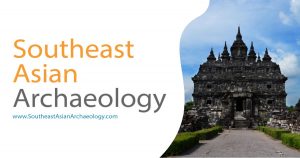After a few days of news about the so-called “pre-Angkor” civilisation at the Bujang Valley, I was pleasantly surprised to read the AP’s (a notably non-local media organisation) focus on the iron-smelting discovery. There is an interesting question as to whether the remains that dot the valley really constitute as a ‘civilisation’ or not. What we do know is that the area seems to have been inhabited from the 3rd or 4th century right up to the 11th or 12th century. There are two main theories about the Bujang Valley settlement: was it was an outpost for Indian traders, who made a settlement there to stay for up to half a year while waiting for the monsoon winds to bring them back to India? Another theory is that the settlement was indigenous, and was gradually ‘Indianized’ from contacts with Indian traders – hopefully archaeological evidence can uncover which condition is true.
Our main source of archaeological information is from the ruins themselves, most of which appear to be remains of Buddhist stupas or Hindu temples with votive offerings; the tropical climate and frequent floods mean that there is little chance for human and other organic remains will be found. I am skeptical about the identification of one of the newly unearthed buildings as a house because houses in this region tend to be made from wood rather than stone. (Note: While affiliated with the Global Centre for Archaeological Research, I am not involved with this excavation in any way.)
One more note about iron smelting in Southeast Asia – the earliest evidence for such is around 1,500 BCE in the mainland, but the ranges of dates from the region go to as late as 500 CE. It does look as if the technology for metalworking diffused out from the mainland, probably from the north to south.
Malaysian dig reveals ancient people mastered iron
AP, via International Herald Tribune, 06 March 2009
Other than the Hindu and Buddhist temples that have been uncovered, little is known about the people of the Bujang Valley. There is even debate over whether they were an actual civilization.
Harry Truman Simanjuntak, a researcher at the National Research Center of Archaeology in Jakarta who was not involved in the dig, said the dating of the iron smelt to the third or fourth century appears reasonable.
But he cautioned that more evidence must be unearthed before concluding the Bunjang Valley people were an actual civilization, defined by complex hierarchical social and other structures.
“It’s too early to say it is a civilization,” he said.
Mokhtar argues the Bujang people are a civilization because temples imply a social structure.

























i read that one too when it first came out. I wonder how and why AP gets Prof Truman Simanjuntak to comment all the time. I remember the AP article on the 1.83 million year old handaxe, in which Prof Simajuntak was quite skeptical too.
It’s good though. To get a different view. Just wondering why it is that we only hear from Prof Simajuntak again and again in AP. what do other scholars think?
It’s probably a function of how the media works. Most reporters keep a list of experts who they can refer to – and comment on the archaeological news of the hour. It looks like Prof Truman is their go-to expert for anything archaeology in the Malay world.
This is so exciting! Thanks for sharing the news, Noel!